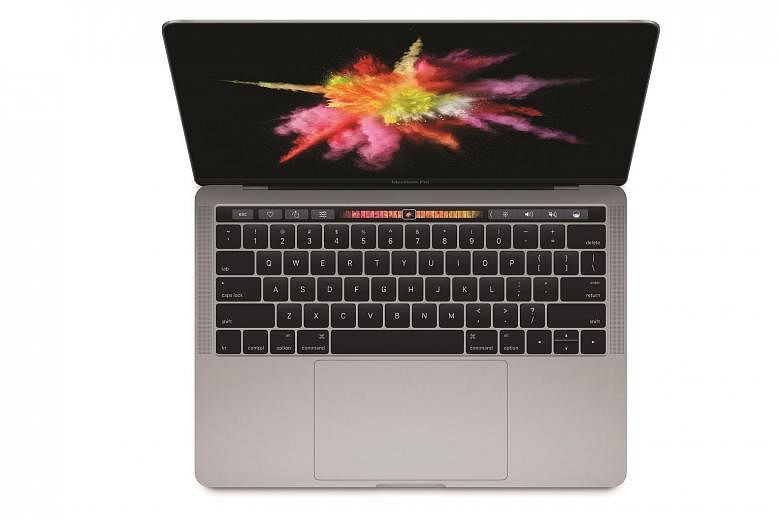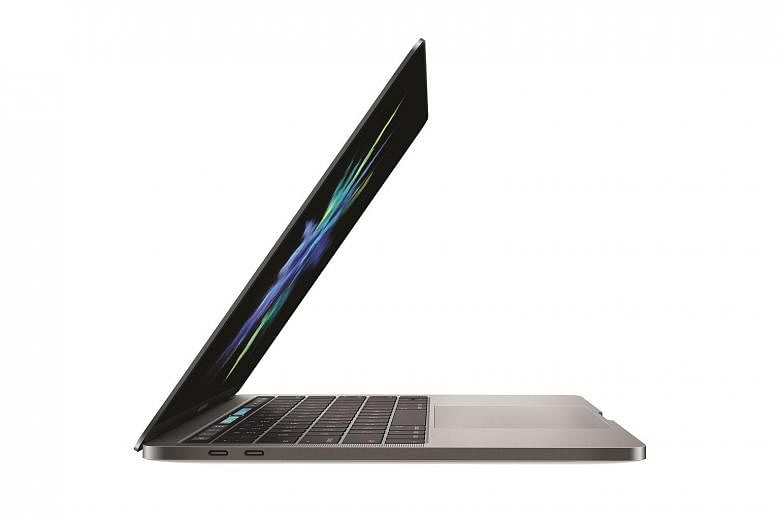SINGAPORE - My Apple MacBook Air and I have been all but inseparable for the past four years.
But I was hoping for a new MacBook Pro that's as skinny and light as my MacBook Air, but way more powerful. My wish came true with the new MacBook Pro, launched in Singapore today.
Its redesigned MacBook Pro has the thinner chassis I craved, but with sixth-generation Intel Core processors. The new Pro adds a Touch Bar, an organic light-emitting diode (Oled) touchscreen, and Touch ID fingerprint sensor like the one on the iPhone.
The trackpad has been upsized, so it's nearly 50 per cent bigger than before.
But the SD card slot, HDMI and USB 3.0 ports are history. In their place are four Thunderbolt 3 ports - two on either end of the laptop - that also support USB-C.
What does remain - surprise, surprise - is the 3.5mm headphone jack.
I know that some users are up in arms over Apple's decision to ditch all the common ports and go with Thunderbolt 3. But it is not something that adapters cannot solve.
The MacBook Pro with the Touch Bar and four Thunderbolt 3 ports comes in 13-inch (from $2,588) and 15-inch (from $3,388) models. Both are now also available in space grey, as well as the usual silver.
Apple also offers an entry-level 13-inch MacBook Pro minus the Touch Bar (from $2,188) and with only two Thunderbolt 3 ports.
I have been using an higher-end version of 13-inch MacBook Pro with the Touch Bar ($2,788) for a few days. And this is what I think so far.
DESIGN
The new MacBook Pro looks like the offspring of the old MacBook Pro and the newer 12-inch MacBook introduced in 2015.
Like the 12-inch MacBook, the new Pro has a metallic Apple logo on its lid. No more Apple glow. Lift the lid, and you find speaker grilles flanking the keyboard just like in the MacBook Pro of old.
The newcomer's keyboard has the second-generation butterfly mechanism - first found in the MacBook - which is four times more stable than the scissor mechanism. The keys feel more responsive and have a better tactile feel than those of the MacBook. But I would still prefer the keyboard of my MacBook Air.
That said, I had no problem with the keyboard when writing this review. I guess I'll get used to this and maybe even forget how my MacBook Air's keyboard feels.
You can't help noticing that the trackpad is larger than in the older MacBook Pro - 46 per cent larger, to be precise. This is supposed to give you better control when moving the cursor around.
The new 13-inch Pro is a uniform 14.9mm throughout (contrast the MacBook Air, which tapers from 17mm to 3mm) and weighs 1.37kg, just a smidgen more than the Air). The 15-inch Pro is 15.5 mm thick and weighs 1.83kg.
TOUCH BAR AND TOUCH ID
And now to the Touch Bar. It is a long Oled touchscreen that sits above the keyboard, replacing the row where the F1-F12 function keys, Escape key and Power button usually reside. The virtual Escape key lights up on the far left when the laptop is powered up.
At the far right end of the Touch Bar is the Touch ID fingerprint reader. This is also the Power button. During set up, you will be asked to enrol your fingerprint . Once this is done, you will be able to unlock the laptop with Touch ID, just like with the iPhone, and also unlock locked Notes and confirm iTunes purchases.
The Touch Bar has a resolution of 2,170 x 60-pixels and can display millions of colours. By default, it will display the standard system controls, such as display brightness, keyboard backlight, media controls, system volume, and Siri. Contextual commands will appear on the Touch Bar when you are using a supported app. The system controls will collapse to the right of the Touch Bar with an arrow for you to expand them again.
There are no third-party apps supporting Touch Bar yet. But Adobe and Microsoft have pledged support for the Touch Bar. I look forward to using the Touch Bar particularly for Photoshop and Lightroom.
For now, only the native Apple apps, such as Mail, Safari and Photos, support the Touch Bar.
In Mail, you get commands, such as Archive, Move to and Flag. Those commands are readily available by clicking on icons on the app itself. It is just easier to just tap the commands on the Touch Bar.
I find the Touch Bar more useful in Photos. The thumbnail pane allows you to browse through the thumbnails by sliding your finger along the Touch Bar. You can also simply tap on the photo you want. In Safari, you can move between tabs using the same sliding action too.
The Touch Bar looks sharp and feels very responsive, whether you are tapping on a button or sliding on a brightness setting.
Even with only Mail, Safari and Photos apps now, the Touch Bar feels like a great aid to your workflow. Granted that its success will ultimately rest squarely on whether developers provide support. If not, it might well be an under-utilised piece of glass sitting above the keyboard.
Will I be replacing my MacBook Air with the new 13-inch MacBook Pro? I'll need to try the 15-inch MacBook Pro first. But I have a feeling that the larger screen size will make for easier viewing.
For a full review of the 13-inch and 15-inch MacBook Pro (Late 2016, Touch Bar and Touch ID), look out for next week's issue of The Straits Times Digital on Nov 23.



